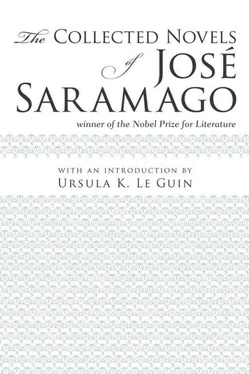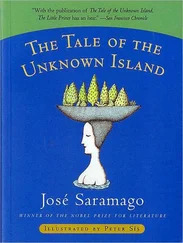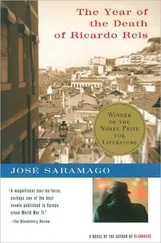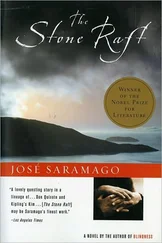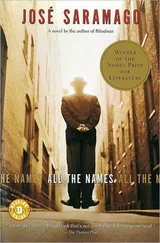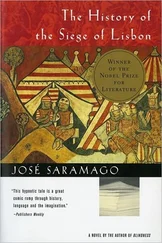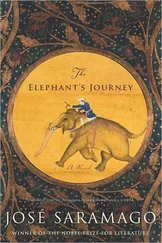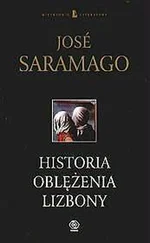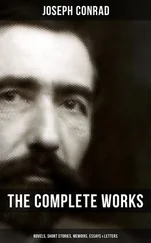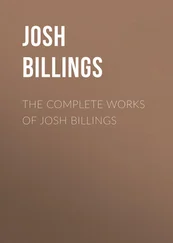The preparations took up the whole of the following day. First from one house, then from the other, Marta and Isaura selected what they thought was necessary for a journey that had no known destination and which no one knew how or where it would end. The two men loaded the van, helped by encouraging barks from Found, not in the slightest bit worried today about what was, quite clearly, another move, because the idea never even entered his doggy head that they might be about to abandon him again. The morning of their departure dawned beneath a graying sky, it had rained in the night, here and there in the yard there were small puddles of water, and the mulberry tree, forever bound to the earth, was still dripping. Shall we go, asked Marçal, Yes, let’s go, said Marta. They climbed into the van, the two men in front and the two women behind, with Found in the middle, and just as Marçal was about to start the engine, Cipriano Algor said abruptly, Wait. He got out of the van and went over to the kiln, Where’s he going, asked Marta, What’s he going to do, murmured Isaura. The kiln door was open, Cipriano Algor went in. When he emerged shortly afterward, he was in his shirtsleeves and was using his jacket to carry something heavy, a few figurines, it couldn’t be anything else, He probably wants to take some with him as a souvenir, said Marçal, but he was wrong, Cipriano Algor went over to the door of the house and started arranging the figurines on the ground, placing them firmly in the damp earth, and when he had put them all in their positions, he went back to the kiln, by then, the other travelers had got out of the van too, no one asked any questions, one by one they went into the kiln as well and brought out the figurines, Isaura ran to the van to fetch a basket, a sack, anything, and the area in front of the house gradually filled up with figurines, then Cipriano Algor went into the pottery and very carefully removed from the shelves the defective figurines gathered there and reunited them with their sound and perfect siblings, the rain would eventually turn them into mud, and then into dust when the sun dried the mud, but that is a fate we all will meet, now the figurines are not just guarding the front of the house, they are defending the entrance to the pottery too, in the end, there will be more than three hundred figurines, eyes front, clowns, jesters, Eskimos, mandarins, nurses, bearded Assyrians, Found has not yet knocked over a single one, Found is a very conscientious, sensitive dog, almost human, he does not need anyone to explain to him what is going on. Cipriano Algor went and shut the kiln door, then he said, Right, now we can go. The engine started and the van went down the hill. When they got to the road, it turned left. Marta, though dry-eyed, was sobbing, Isaura had her arms about her, while Found lay curled up in one corner of the seat, not knowing who to comfort first. After a few kilometers, Marçal said, I’ll write to my parents when we stop for lunch. And then, addressing Isaura and his father-in-law, There was a poster, one of those really big ones outside the Center, can you guess what it said, he asked. We’ve no idea, they replied, and, as if he were reciting something, Marçal said COMING SOON, PUBLIC OPENING OF PLATO’S CAVE, AN EXCLUSIVE ATTRACTION, UNIQUE IN THE WORLD, BUY YOUR TICKET NOW.
Reading Group Guide
1. In addition to The Center’s cave, excavated at the end of the novel, caves are also used by Cipriano to house his rejected pottery; he even jokes that archaeologists might misinterpret these items centuries from now. What relics—frightening or treasured—would best represent your impressions of the twenty-first century so far?
2. The Cave addresses themes of city and countryside, nature and artificiality, most notably in the descriptions of The Center as compared to those of Cipriano’s house. Does your community more closely resemble The Center or the rural area around it? Has mass marketing affected the way you live?
3. Life at The Center is driven by customer surveys, hierarchies, and rigorously enforced regulations. Advertising slogans replace wise proverbs, and curiosity is discouraged. What is the true source of The Center’s malevolence? Who is responsible for its creation and expansion?
4. Marta’s imminent child and Cipriano’s wistful comments regarding the pottery becoming a family business indicate the multigenerational thread of The Cave. What is the significance of this thread? What does the pottery represent to Cipriano in terms of posterity? What do you predict your aspirations will be when you reach Cipriano’s stage of life? Do finances enhance or interfere with the use of your innate talents?
5. Marçal undergoes perhaps the most extensive transformation of all in The Cave. In what way do his contentious parents and his early bouts of competitiveness with Cipriano shape the storytelling? How does Marta cope with her conflicting loyalties?
6. How are creativity and profit reconciled in contemporary economics? Do you believe that today’s artisans fare better or worse than their predecessors a generation ago?
7. Discuss Cipriano’s choice of characters for the figurines: a nurse, an Alaskan, a bearded Assyrian, a mandarin, and a clown, and a jester. How do they complement each other? What does this assortment indicate about its creator?
8. The Center takes on a God-like role in the lives of its inhabitants and vendors. How does its power compare to that exercised by Cipriano when he must determine which figurines are defective and which ones are acceptable?
9. What is Found’s role in the novel? How does his canine perception of the world measure up to reality? What does his new family find in him?
10. What do the novel’s primary characters hope for? What keeps Isaura and Cipriano apart? What finally unites them?
11. The Cave bears several hallmarks of Saramago’s literary form: lines of dialogue are not differentiated with quotation marks, paragraphs might unfold over several pages, and innocuous details take center stage in the midst of suspense. In what way do these elements enhance the believability of Saramago’s fiction?
12. Envisioning Saramago’s novels as one continuum, in what way does The Cave respond to his previous characters and scenarios?
13. Did your attitude toward Cipriano shift throughout the novel? What did you make of him at first?
14. The novel ends with the family’s reunion and liberating departure. Where do you imagine they are going? What would their version of idyllic living be like?
For reading group guides of other Harcourt books, please visit us at www.HarcourtBooks.com.
A HARVEST BOOK • HARCOURT, INC.
Orlando Austin New York San Diego Toronto London
© José Saramago e Editorial Caminho, SA, Lisboa—2000
English translation copyright © 2002 by Margaret Jull Costa
All rights reserved. No part of this publication may be reproduced or transmitted in any form or by any means, electronic or mechanical, including photocopy, recording, or any information storage and retrieval system, without permission in writing from the publisher. Requests for permission to make copies of any part of the work should be mailed to the following address: Permissions Department, Harcourt Inc., 6277 Sea Harbor Drive, Orlando, Florida 32887-6777.
This is a translation of A Caverna
www.HarcourtBooks.com
Library of Congress Cataloging-in-Publication Data
Saramago, José.
[Caverna. English]
The cave/José Saramago; translated from the Portuguese
by Margaret Jull Costa.—1st U.S. ed.
p. cm.
ISBN 0-15-100414-5
ISBN 0-15-602879-4 (pbk.)
I. Costa, Margaret Jull. II. Title.
PQ9281.A66 C3813 2002
869.3’42—dc21 2002002355
Читать дальше
